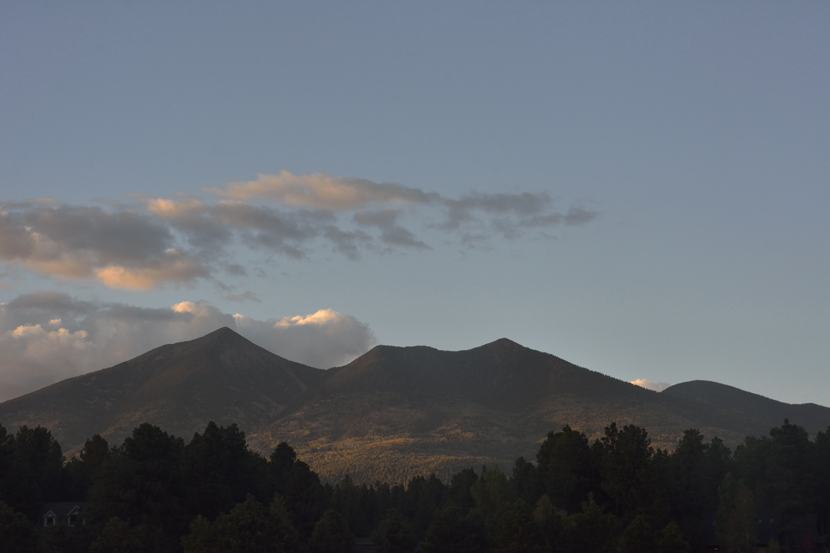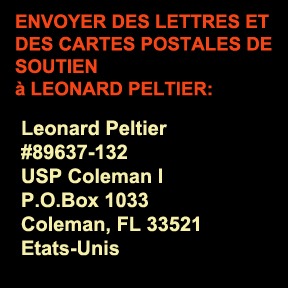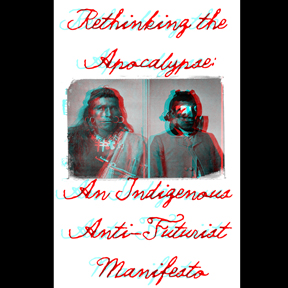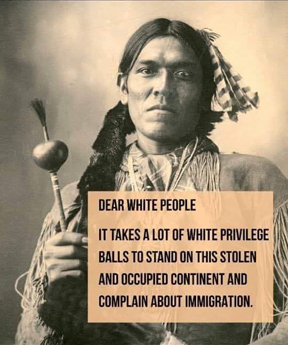In the very last case against Arizona Snowbowl, a court ruled against the Hopi Tribe, on November 29th 2018. Other Tribes and environmental groups have been fighting against Snowbowl for decades. The Save the Peaks Coalition brought the case so far as in the Supreme Court. The case was dismissed, the Coalition had to cease to exist, their lawyer was threatened and they had to remove the Save the Peaks website! Courts said they had no right to keep prosecuting on an already decided case. Then, the Hopi Tribe filed a case against the City of Flagstaff for selling reclaimed wastewater to Arizona Snowbowl. This was the very last hope for people fighting Snowbowl. On November 29th, the court ruled against the Hopi Tribe case, mainly on the ground that the injuries they claimed would be brought to them by artificial snow, did not threaten private property or pecuniary interests!
Christine Prat
On Novembre 29th, Klee Benally sent this message onFacebook:
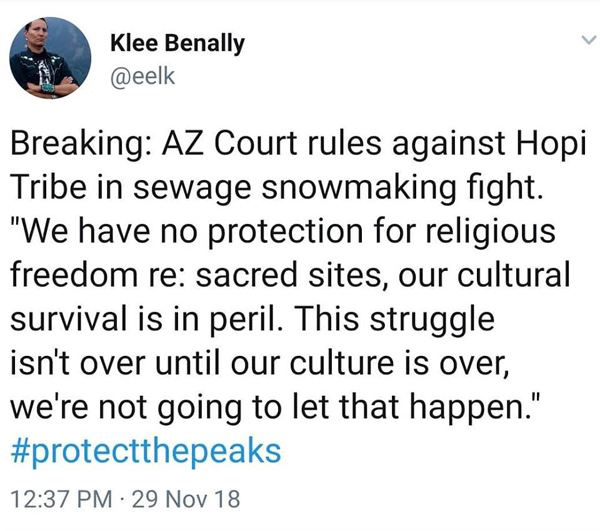
Some excerpts of the ruling
 ¶2 The use of reclaimed wastewater for snowmaking on northern Arizona’s San Francisco Peaks has been extensively debated and litigated. This case is the latest chapter of that dispute. Over sixteen years ago, the City of Flagstaff contracted to sell reclaimed wastewater to Arizona Snowbowl Resort Limited Partnership (“Snowbowl”) for artificial snowmaking at its ski area on the Peaks. Because the Peaks are located on federal land, this prompted the United States Forest Service to conduct a lengthy environmental impact inquiry, culminating in that agency’s approval. Thereafter, various tribes (including the Hopi Tribe), environmental groups, and other interested parties unsuccessfully challenged the proposed snowmaking under several federal laws, including the Religious Freedom Restoration Act (“RFRA”) of 1993, 42 U.S.C. §§ 2000bb to 2000bb-4. See Navajo Nation v. U.S. Forest Serv., 535 F.3d 1058 (9th Cir. 2008) (en banc).
¶2 The use of reclaimed wastewater for snowmaking on northern Arizona’s San Francisco Peaks has been extensively debated and litigated. This case is the latest chapter of that dispute. Over sixteen years ago, the City of Flagstaff contracted to sell reclaimed wastewater to Arizona Snowbowl Resort Limited Partnership (“Snowbowl”) for artificial snowmaking at its ski area on the Peaks. Because the Peaks are located on federal land, this prompted the United States Forest Service to conduct a lengthy environmental impact inquiry, culminating in that agency’s approval. Thereafter, various tribes (including the Hopi Tribe), environmental groups, and other interested parties unsuccessfully challenged the proposed snowmaking under several federal laws, including the Religious Freedom Restoration Act (“RFRA”) of 1993, 42 U.S.C. §§ 2000bb to 2000bb-4. See Navajo Nation v. U.S. Forest Serv., 535 F.3d 1058 (9th Cir. 2008) (en banc).
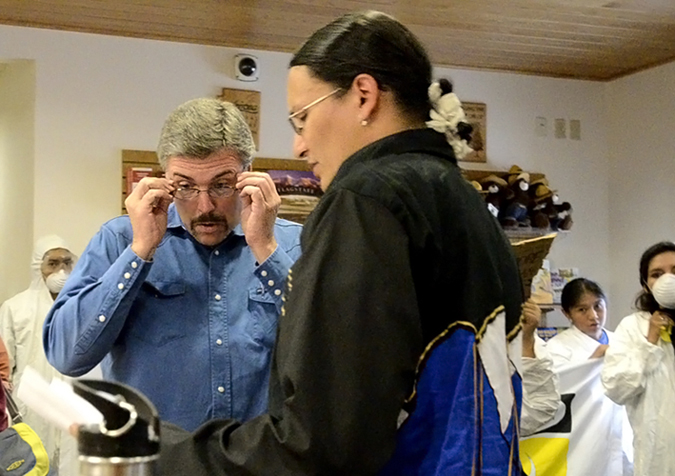 My commentary: On September 21st 2012, Klee Benally and other Peaks Protectors – and myself, for taking pictures – went to the Flagstaff Office of the Forest Service, to deliver a letter addressed to then Secretary of Agriculture Tom Vilsack, with a copy to Mr. Earl Stewart, head of the Forest Service in Flagstaff. After the action, which lasted less than 7 minutes, we stayed outside chatting for some time. At a point, one of the Protectors came to tell us that there was panic inside, that the office was closed, because a bucket brought by one of the Protectors had been spilled. A label on the bucket listed all the chemicals and possibly dangerous stuffs that could be contained in the controversial recycled water. Almost three months later, arrest warrants were issued against several individuals who had taken part in the action.
My commentary: On September 21st 2012, Klee Benally and other Peaks Protectors – and myself, for taking pictures – went to the Flagstaff Office of the Forest Service, to deliver a letter addressed to then Secretary of Agriculture Tom Vilsack, with a copy to Mr. Earl Stewart, head of the Forest Service in Flagstaff. After the action, which lasted less than 7 minutes, we stayed outside chatting for some time. At a point, one of the Protectors came to tell us that there was panic inside, that the office was closed, because a bucket brought by one of the Protectors had been spilled. A label on the bucket listed all the chemicals and possibly dangerous stuffs that could be contained in the controversial recycled water. Almost three months later, arrest warrants were issued against several individuals who had taken part in the action. 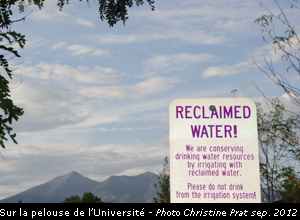 They heard about it – just as I did – from an article published in the Arizona Daily Sun. The spilled bucket seemed to be at the center of the fuss, and the article listed the chemicals supposed to be contained in it. Anyone who had more or less read about the artificial snow dispute could immediately recognize the stuff that opponents claimed was contained in recycled water. The panic at the Forest Service apparently meant that they approved of snowmaking with sewage water without knowing what was in it! Ch. P
They heard about it – just as I did – from an article published in the Arizona Daily Sun. The spilled bucket seemed to be at the center of the fuss, and the article listed the chemicals supposed to be contained in it. Anyone who had more or less read about the artificial snow dispute could immediately recognize the stuff that opponents claimed was contained in recycled water. The panic at the Forest Service apparently meant that they approved of snowmaking with sewage water without knowing what was in it! Ch. P
¶3 Following that federal court litigation, Snowbowl, the City, the United States Department of Agriculture, and the Hopi Tribe continued to discuss potential alternatives to reclaimed water. No agreement was reached, however, and the Tribe persistently alleged that no proposed administrative actions “could mitigate the adverse effects of using reclaimed wastewater for artificial snowmaking at the Snowbowl.” The City also held public hearings on the matter, at which the Tribe and other interested parties voiced their opposition to the use of reclaimed wastewater on the Peaks. In 2010, the City ultimately voted to proceed with the reclaimed water contract and, after more public comment, denied a motion to reconsider.
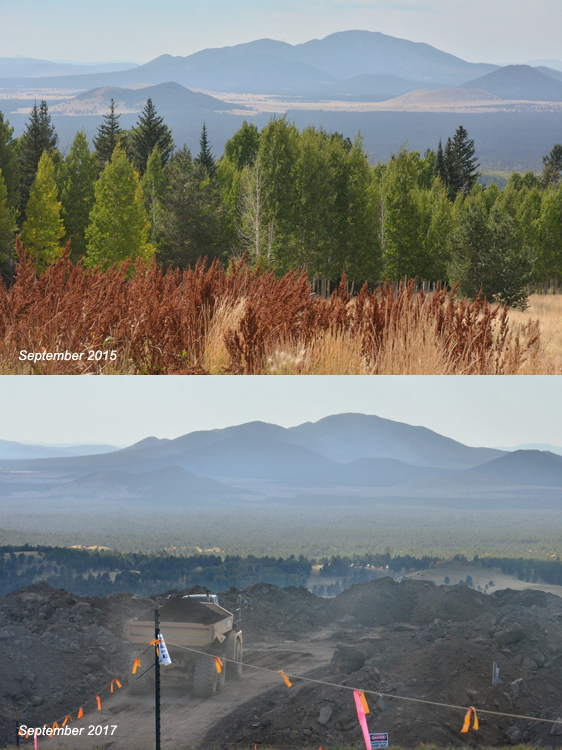 ¶4 The Hopi Tribe then filed this action in 2011 against the City on various state law grounds, alleging among other things that the City’s “sale of reclaimed wastewater to make artificial snow” is a public nuisance that “will result in unreasonable harm to the environment and the Hopi Tribe.” As described in the Tribe’s complaint, “[r]eclaimed wastewater is water that has been used and circulated through the City’s
¶4 The Hopi Tribe then filed this action in 2011 against the City on various state law grounds, alleging among other things that the City’s “sale of reclaimed wastewater to make artificial snow” is a public nuisance that “will result in unreasonable harm to the environment and the Hopi Tribe.” As described in the Tribe’s complaint, “[r]eclaimed wastewater is water that has been used and circulated through the City’s
municipal water sewer system, has passed through a treatment facility, and meets certain standards.” The Tribe further alleged it “has special interests in the environment, including the flora and fauna, of the San Francisco Peaks in the immediate vicinity of the Snowbowl Resort Area.” The Tribe also claimed it “will suffer specific injury” from the “runoff, windblown snow, increased unnatural noise, and elevated air pollution [that] will pervade beyond the Snowbowl Resort Area” and into areas the Tribe uses “for ceremonial practices, hunting[,] . . . the gathering of natural resources[,] . . . and utilitarian purposes.” For example, “[n]atural resources that the Hopi collect, as well as shrines, sacred areas, and springs on the Peaks will come into contact with the blown reclaimed wastewater,” “negatively impact[ing]” the Tribe’s use of the wilderness and surrounding areas. More broadly, the Tribe alleged that “the Snowbowl expansion project,” “additional traffic,” and the very “presence of the Snowbowl Resort” itself will adversely impact the “natural environment” and unduly interfere with the Tribe’s cultural use of the public wilderness for religious and ceremonial purposes.
 About additional traffic, French public radio said a few years ago, during the big rush to the ski stations in the Alps, that, with that additional traffic, the level of pollution on the highest tops equaled that of central Paris in the rush hours. Ch. P
About additional traffic, French public radio said a few years ago, during the big rush to the ski stations in the Alps, that, with that additional traffic, the level of pollution on the highest tops equaled that of central Paris in the rush hours. Ch. P
¶16 The dissent argues that “[t]hese cases do not require that the interest at stake be a property or pecuniary interest.” Infra ¶ 52. Perhaps not expressly, but they all involved damage to or interference with such an interest and do not support recognizing a new place-of-special-importance category. And we see good reason for generally adhering to a property- and pecuniary-interest-based approach because, unlike the proposed new category, it comports with the underlying, two-part rationale for the special injury requirement.
In short, although the Law does not clearly require it, people can complain about increased injuries only if they threaten private property or pecuniary interests, and forget about health or environment! CAPITALISM IS THE ENEMY OF MOTHER EARTH!
Christine Prat

